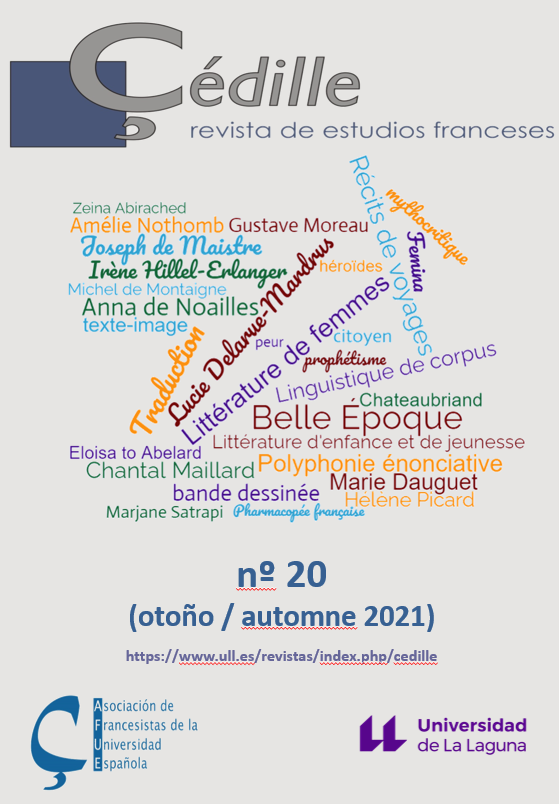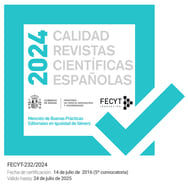La combinatoria de /peur/ con verbos en un diccionario sintáctico-combinatorio bilingüe francés-español (TACTICOMB)
Resumen
Los estudios de combinatoria léxica basados en corpus han dado a luz varias obras clave en la lexicografía combinatoria, tanto para gran público, como para público especializado. Recientemente hemos observado además algún intento de diccionario combinatorio bilingüe. Tenemos como meta el diseño de un diccionario combinatorio bilingüe francés-español que, aunando elementos combinatorios, semánticos y sintácticos, sirva de manera eficaz para la producción y la traducción. Tras un breve estudio comparado de las palabras de MIEDO peur y miedo, particularmente a través de su combinatoria léxica analizada con ayuda de Sketch Engine en grandes corpus comparables y paralelos, ilustraremos el diseño del diccionario con un modelo de entrada para la combinatoria de peur con verbos en francés-español.
Citas
ALONSO RAMOS, Margarita (1995): «Hacia una definición del concepto de colocación: de J. R. Firth a I. A. Mel’čuk». Revista de Lexicografía, 1, 9-28.
ALONSO RAMOS, Margarita (2001): «Construction d’une base de données des collocations bilingue français-espagnol». Langages, 143, 5-27. URL: https://www.persee.fr/doc/¬lgge_0458 726x_2001_num_35_143_888.
ALONSO RAMOS, Margarita (2004): Diccionario de colocaciones del español. DICE. URL:: http://www.dicesp.com/paginas [DICE].
ALONSO RAMOS, Margarita (2017): «Diccionarios combinatorios». Estudios de Lingüística del Español, 38, 173-201. URL: https://doi.org/10.3406/lgge.2001.888.
AUGUSTYN, Magdalena & Agnès TUTIN (2009): «Constitution d’un corpus annoté autour du lexique des émotions: collocations et fonctions lexicales», in D. Beck et al. (eds.), Fourth International Conference on Meaning-Text Theory. Proceedings. Montréal, OLST, 25-34. URL: http://olst.ling.umontreal.ca/pdf/ProceedingsMTT09.pdf.
BARTNING, Inge (1997): «L’apprenant dit avancé et son acquisition d’une langue étrangère». AILE, 9, 9-50. URL: http://journals.openedition.org/aile/1316.
BEAUCHESNE, Jacques; Maude BEAUCHESNE & Kim BEAUCHESNE (2009): Le Grand Dictionnaire des cooccurrences. Québec, Guérin. [GDDESCOOC]
BOSQUE, Ignacio [dir.] (2004): Redes. Diccionario combinatorio del español contemporáneo. Madrid, SM. [REDES]
BOSQUE, Ignacio [dir.] (2011): Diccionario combinatorio práctico del español contemporáneo. Madrid, Ediciones SM. [PRACTICO]
DENIS, Serge et al. (1976): Dictionnaire espagnol-français. París, Hachette. [DHEF]
DIWERSY, Sascha et al. (2014): «Traitement des lexies d’émotion dans les corpus et les applications d’EmoBase». Corpus, 13, 269-293. URL: http://journals.openedition.¬org/corpus/2537.
FRANÇOIS, Jacques & Sascha DIWERSY (2014): «À propos des verbes d’émotion en allemand et en français: la sélection du sujet grammatical dans le micro-champ des verbes de la peur, étude quantitative à l’aide de corpus de textes littéraires et journalistiques comparables», in P. Blumenthal et al., Les émotions dans le discours-Emotions in Discourse. Frankfurt, Peter Lang, 15 38.
GARCIA PELAYO, Ramón y Jean TESTAS (2000): Dictionnaire français-espagnol/espagnol-français. Barcelona, Larousse. [DLFE]
GOMEZ, Araceli & Isabel UZCANGA (2010): «Pour une nouvelle approche de la lexicographie bilingue français > espagnol», in F. Neveu et al. (eds.): Congrès mondial de linguistique française. París, Institut de linguistique française, 981 989. URL: https://doi.org/¬10.1051/cmlf/2010244.
HOEY, Michael (2005): Lexical priming. A new theory of words and language. London, Routledge (Taylor and Francis). [Formato Kindle].
JAKUBÍČEK, Miloš et al. (2013): «The TenTen corpus family», in A. Hardie y R. Love (eds.), 7th International Corpus Linguistics Conference. Abstract book. Lancaster, 125-127. URL: https://www.sketchengine.eu/wp-content/uploads/The_TenTen_Corpus_¬2013.pdf.
KILGARRIFF, Adam et al. (2004a): Sketch Engine. URL: https://www.sketchengine.eu.
KILGARRIFF, Adam et al. (2004b): «ITRI-04-08 The Sketch Engine». Information Tech-nology, 7, 105-116. URL: https://www.researchgate.net/publication/260387608_ITRI-04-08_the_sketch_engine.
KILGARRIFF, Adam et al. (2014): «The Sketch Engine: Ten Years On». Lexicography: Journal of ASIALEX, 1: 1, 7-36.
KLEIN, Wolfgang (1994): Time in language. Brighton, Psychology Press.
LAMBERT, Monique (1997): «En route vers le bilinguisme». Acquisition et interaction en langue étrangère, 9, 147-172. URL: https://journals.openedition.org/aile/732#bibliography.
LAROUSSE (s.f.): Dictionnaire français-espagnol/espagnol-français. URL: https://larousse.fr/dictionnaires/francais-espagnol y https://larousse.fr/dictionnaires/espagnol-francais. [DLFE-e]
LE FUR, Dominique (2007): Dictionnaire de combinaisons de mots. París, Robert. [DCMR]
LEGALLOIS, Dominique (2012): «La colligation: autre nom de la collocation grammaticale ou autre logique de la relation mutuelle entre syntaxe et sémantique?». Corpus, 11, s.p. URL: http://journals.openedition.org/corpus/2202.
LÉPINETTE, Brigitte (1989): «Vers un dictionnaire explicatif et combinatoire bilingue». Cahiers de lexicologie, 54, 105 162. URL: https://doi.org/10.15122/isbn.978-2-8124-4307-7.p.0105.
LEVELT, Wilhem (1989): Speaking: from intention to articulation. London, M.I.T. Press.
MEL’ČUK, Igor (1982): «Lexical functions in lexicographic description», in M. Macaulay et al. (eds.), Proceedings of the Eighth Annual Meeting of the Berkeley Linguistics Society. Berkeley, UCB, 427-444.
MEL’ČUK, Igor (2015): Semantics. From meaning to text. Vol. 3, Amsterdam, Benjamins.
MEL’CUK, Igor et al. (1984-1999): Dictionnaire explicatif et combinatoire du français contemporain: Recherches lexico-sémantiques. Vol. I-IV. Montreal, Presses de l’Université de Montréal. [DECF]
MEL’CUK, Igor et al. (1995): Introduction à la lexicologie explicative et combinatoire. Louvain-la-Neuve/París, Duculot/AUPELF-UREF.
MEL’CUK, Igor et al. (2007) : Lexique actif du français. Bruxelles, Duculot. [LAF]
MEL’ČUK, Igor y Jasmina MILIĆEVIĆ (2020): An advanced introduction to semantics. A meaning-text approach. Cambridge, Cambridge University Press. Edición Kindle.
ORTONY, Andrew et al. (1988): La estructura cognitiva de las emociones. Madrid, Siglo XXI.
PERDUE, Clive (1993): «Comment rendre compte de la “logique de l’acquisition” d’une langue étrangère par l’adulte?». Études de Linguistique Appliquée, 92, 8-22.
SANZ ESPINAR, Gema (2001): «El libro bifronte. la representación del francés y del español en el diccionario bilingüe», in Mª. Pilar Suárez et al. (eds.), L'autre et soi-même: la identidad y la alteridad en el ámbito francés y francófono. Madrid, UM/Ima Ibérica, 445-454.
SANZ ESPINAR, Gema (2020): «Verbos de movimiento en un diccionario bilingüe sintáctico-combinatorio francés-español: TACTICOMB». Anales de Filología Francesa, 28: 1, 627-650.
SANZ ESPINAR, Gema & Aránzazu GIL CASADOMET (2019): «Vers un dictionnaire combinatoire bilingue français-espagnol : approche des mots renvoyant à la 'peur' en français et en espagnol à travers leur combinatoire lexicale et leur comportement dans de grands web-corpus». Comunicación oral presentada en el XXVIII Coloquio de la Asociación de Francesistas de la Universidad Española (“Un certain regard. La langue française pour penser, appréhender et exprimer le monde”). Universidad Autónoma de Madrid.
SLOBIN, Dan (1991): «Learning to think for speaking: native language, cognition and rethorical style». Pragmatics, 1: 1, 7-25.
SLOBIN, Dan & Aurora BOCAZ (1988): «Learning to talk about movement through time and space: the development of narrative abilities in Spanish and English». Lenguas Modernas, 15, 5-24.
TALMY, Leonard (1975): «Semantics and syntax of motion». Syntax and semantics, 4, 181 238.
TALMY, Leonard (1985): «Lexicalization patterns: Semantic structure», in T. Shopen (ed), Lexical Forms, Language typology and Syntactic Description III: Grammatical Categories and the Lexicon. Cambridge, Cambridge University Press, 57-149.
TALMY, Leonard (1988): «Force dynamics in language and cognition». Cognitive Science, 12, 49-100.
TUTIN, Agnès (2013): «Les collocations lexicales: une relation essentiellement binaire définie par la relation prédicat-argument». Langages, 189: 1, 47-63.
TUTIN, Agnès & Francis GROSSMANN (2002): «Collocations régulières et irrégulières : esquisse de typologie du phénomène collocatif». Revue française de linguistique appliquée, VII: 1, 7-25.










